The Role of Video Cameras and Emerging Technologies in Disaster Response to Increase Sustainability of Societies: Insights on the 2023 Türkiye–Syria Earthquake
Abstract
1. Introduction
1.1. Description of the Earthquakes
1.2. In-Field Instrumentation and Dissemination of Information
1.3. Organization of the Paper
- PART I—Qualitative Insights Into New Technologies For Disaster Response And Scientific Progress
2. New Technology’s Advances
2.1. Satellites
2.1.1. Crustal Deformation
- -
- Compatibility between strain rates obtained via GPS and rates of occurrence, especially for cases of complex tectonics, such as the Anatolian plate.
- -
- Kinematics of rupture: the first event occurred along 300 km, approximately 150 km on either side of the fault from the epicentre; the second event had a different mechanism.
- -
- Wave propagation is clearly influenced by the path (orogeny, topography) and geotechnical 3D site effects.
- -
- Directional effects on rupture (fling, pulse-like) and Doppler effects. During the 4:17 a.m. event, damage appears concentrated along the fault trace, and it would be very insightful to determine if collapses essentially occurred during the fling passage.
- -
- Uncertainties in the process of defining seismic action. Moreover, the hazard and the most updated recommendations [48] were below the observed seismic field, especially over long periods.
- -
- The possibility of stress transfer among faults in the same tectonic environment, as pointed out by Stein et al. [75], causing interdependences or, in the present case, causing “migration of earthquakes” from Mw 7.8 to Mw 7.6, which must be considered in future hazard modelling in terms of intra-main rupture and intercutting for nearby faults.
2.1.2. Damage Assessment
2.2. Drones
2.2.1. Observations from Drones (Captured during Daylight Only)

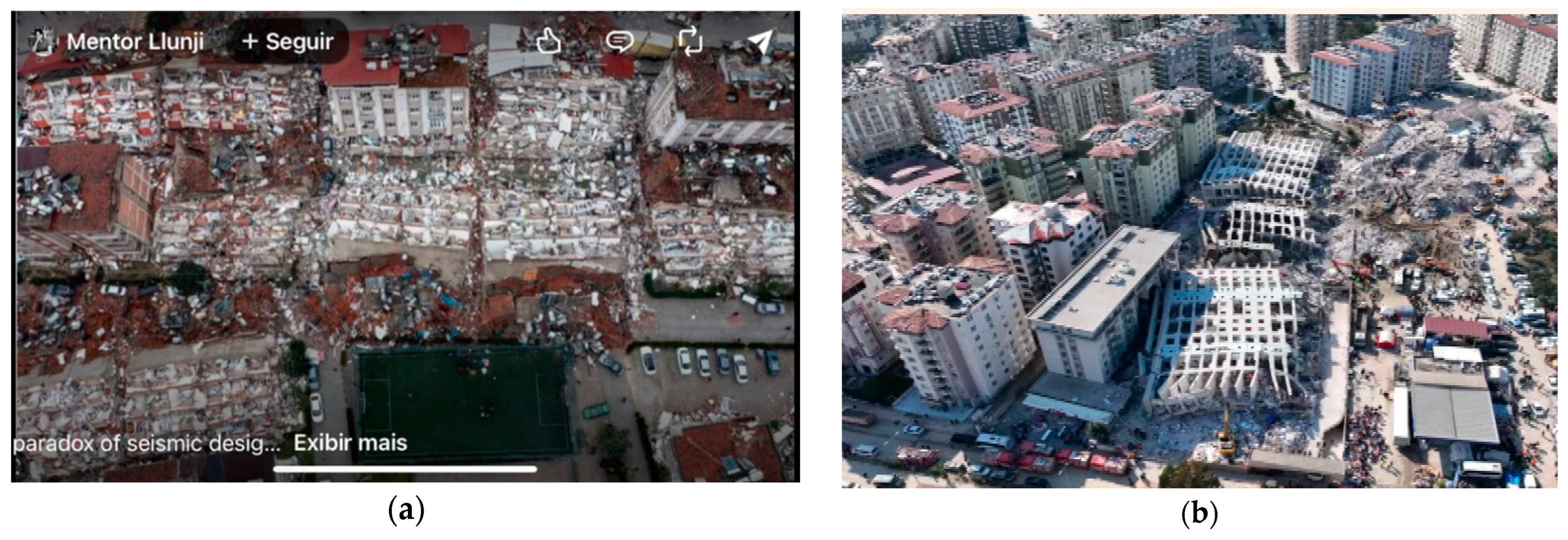
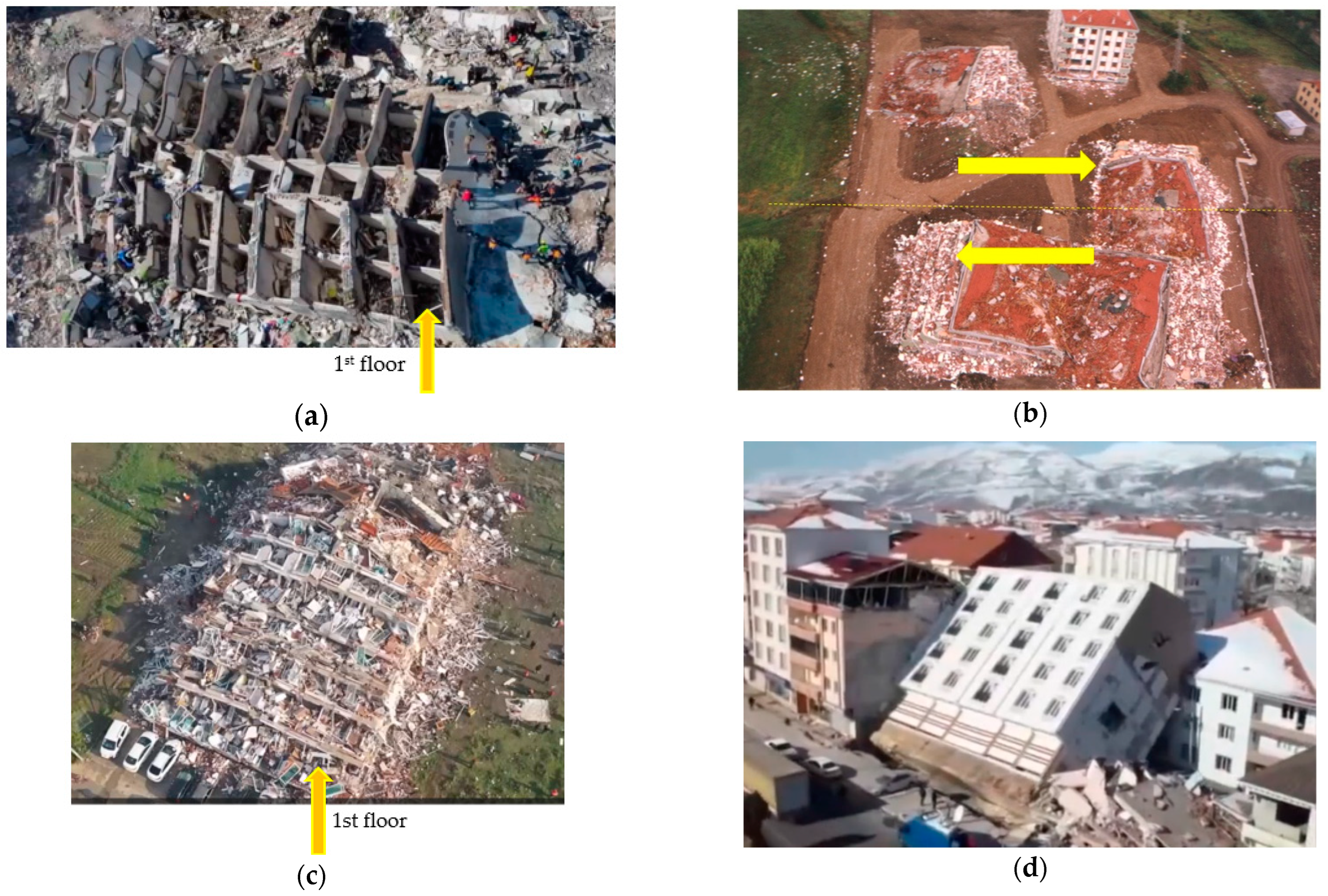
2.2.2. Comparing Prior and Post-Earthquake Images
2.3. Video Cameras
2.3.1. Brief Note on the Evolution of Video Cameras to Study Disasters
2.3.2. Examples of Video Camera Observations during the Türkiye–Syria Events
2.3.3. Seismic Observation Cases
2.3.4. Additional Examples Captured with Video Cameras to Be Used in Conjunction with Macroseismic Intensity Scales
- PART II—Quantitative Insights: Drone Imagery and Video Camera Capabilities in Understanding Road Blockages and Wave Propagation
3. Blockage with Debris: A Model Suggested from Field Observation (from Pictures and Drones)
3.1. Amount of Debris Generated by Destructive Earthquakes
3.2. Prior Studies on Road Obstructions
3.3. Proposal of a Model for Assessing Road Blockages after Earthquakes and Comparative Analyses
- -
- When buildings collapse between adjacent structures, the collapse tends to be nearly vertical, resulting in debris being confined to a limited area. ((Figure 18a)-2)
- -
- When isolated buildings without infills collapse and the structural situation is a weak column–strong beam, the hinge is most likely at the connection node. Consequently, the collapsed building often topples to the side, occupying a large amount of space ((Figure 18a)-3, 4).
- -
- In the case of foundation failures (just one floor below ground, or coupled with liquefaction), the complete overturning of the structure is critical ((Figure 18a)-5). This phenomenon can result in the obstruction of roads, either partially or entirely. Similar collapse modes have been constructed for past events, namely for the Kobe earthquake in Japan (1995) and the earthquake in Chile (2010).
4. Quantitative Analyses of Ground Motion with Video Cameras
4.1. Wave Propagation Observed in Objects (Oscillation of Lamps, Water in Tanks, Falling of Objects, etc.)
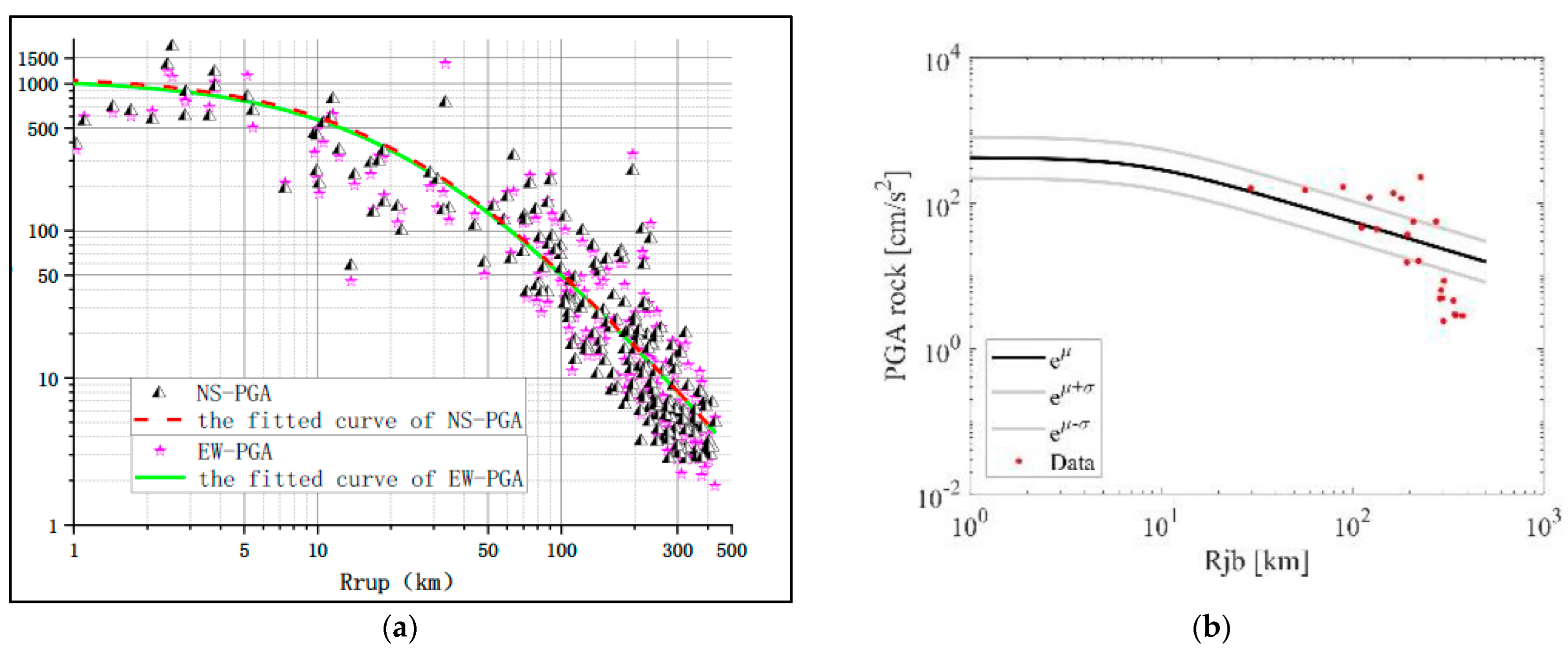
- PART III—Future Initiatives
5. Final Considerations and Future Research
5.1. Final Considerations and Innovations
5.2. Creation of a Collaborative Platform for Satellite, Drone and Video Camera Footage
5.3. Suggestions for Future Study
- -
- As there are no dense SM arrays for considering the intra- and inter-variability of ground motion (GM), further studies should be conducted based on building behaviour. Both drone images and/or video camera footage are essential for these types of studies. The randomness observed in Figure 19a,b should be understood. Additionally, the influence of transverse-longitudinal predominant motion is crucial in determining the predominant orientation of ground motion.
- -
- -
- Road blockages have already been observed. A more quantitative analysis can be performed to provide robust evidence for practical applications such as amount of debris, using drones and satellite images.
- -
- Among the various cases we suggested for analytical studies, we focused on the movement of minarets, as observed in Video #07c. The detected frequency of 0.2 Hz may not correspond to the first mode but is likely related to the ground motion displacement orbit. Further study is needed to clarify this issue.
Supplementary Materials
Author Contributions
Funding
Acknowledgments
Conflicts of Interest
References
- EMSC. Euro Mediterranean Seismological Centre. 2023. Available online: https://emsc-csem.org/Earthquake_information/earthquake.php?id=620925 (accessed on 1 April 2023).
- Avşin, N.; Erturaç, M.K.; Şahiner, E.; Demir, T. The Quaternary Climatic and Tectonic Development of the Murat River Valley (Muş Basin, Eastern Turkey) as Recorded by Fluvial Deposits Dated by Optically Stimulated Luminescence. Quaternary 2021, 4, 29. [Google Scholar] [CrossRef]
- Bozkurt, E.; Mittwede, S.K. Introduction to the Geology of Turkey—A Synthesis. International. Geol. Rev. 2001, 43, 578–594. [Google Scholar] [CrossRef]
- Karabulut, H.; Güvercin, S.E.; Hollingsworth, J.; Konca, A. Long silence on the East Anatolian Fault Zone (Southern Türkiye) ends with devastating double earthquakes (6 February 2023) over a seismic gap: Implications for the seismic potential in the Eastern Mediterranean region. J. Geol. Soc. 2023, 180, jgs2023-021. [Google Scholar] [CrossRef]
- Gülen, L.; Pınar, A.; Kalafat, D.; Özel, N.; Horasan, G.; Yılmazer, M.; Işıkara, A.M. Surface fault breaks, aftershock distribution, and rupture process of the 17 August 1999 İzmit, Turkey Earthquake. Bull. Seismol. Soc. 2002, 92, 230–244. [Google Scholar] [CrossRef]
- TERRA. Turkish Earthquake Recovery and Reconstruction Assessment. 2023. Available online: https://reliefweb.int/report/turkiye/turkiye-earthquakes-recovery-and-reconstruction-assessment (accessed on 27 March 2023).
- Pager and USGS. Available online: https://earthquake.usgs.gov/earthquakes/eventpage/us6000jlqa/pager (accessed on 10 February 2023).
- Hancılar, U.; Şeşetyan, K.; Çaktı, E.; Şafak, E.; Yenihayat, N.; Malcıoğlu, F.S.; Dönmez, K.; Tetik, T.; Süleyman, H. Kahramanmaraş—Gaziantep Türkiye, M7.7 Earthquake, 6 February 2023 (04:17 GMT+03:00): Strong Ground Motion and Building Damage Estimations Preliminary Report (v6); Boğaziçi University, Kandilli Observatory and Earthquake Research Institute, Department of Earthquake Engineering: Istanbul, Türkiye, 2023. [Google Scholar]
- Buckreis, T.B.; Güryuva, A.; İçen, O.; Okcu, A.; Altindal, M.; Aydin, R.; Pretell, A.; Sandikkaya, O.; Kale, A.; Askan, S.; et al. Ground Motion Data from the 2023 Türkiye-Syria Earthquake Sequence; DesignSafe-CI: Miami, FL, USA, 2003. [Google Scholar] [CrossRef]
- EEFIT. The Türkiye Earthquake Sequence of February 2023: A Longitudinal Study Report by EEFIT; Institution of Structural Engineers (IStructE): London, UK, 2024. [Google Scholar] [CrossRef]
- TUSAGA-Aktif. CORS-TR Turkish National Permanent GNSS Network–Active. 2023. Available online: http://www.tusaga-aktif.gov.tr) (accessed on 1 May 2023). (In Turkish)
- ESA. Satellites Support Impact Assessment after Türkiye–Syria Earthquakes. Terrain Deformation. 2023. Available online: https://www.esa.int/Applications/Observing_the_Earth/Satellites_support_impact_assessment_after_Tuerkiye_Syria_earthquakes (accessed on 13 February 2023).
- Zhai, Q.; Zhan, Z.; Chavarria, J.A. Thousand-kilometer DAS array reveals an uncatalogued magnitude-5 dynamically triggered event after the 2023 Turkey earthquake. J. Geophys. Res. Solid Earth 2023, 129, e2023JB027680. [Google Scholar] [CrossRef]
- SRL. Abstracts of the Annual Meeting. February 2023 Mw 7.8 Earthquake Sequence in Turkey. Seismol. Res. Lett. 2023, 94, 2B. Available online: www.srl-online.org (accessed on 19 April 2023).
- Barbot, S.; Luo, H.; Wang, T.; Hamiel, Y.; Piatibratova, O.; Javed, M.T.; Braitenberg, C.; Gurbuz, G. Slip Distribution of the February 6, 2023 Mw 7.8 and Mw 7.6, Kahramanmaraş, Turkey Earthquake Sequence in the East Anatolian Fault Zone. Seismica 2023, 2, 3. [Google Scholar] [CrossRef]
- Zilio, L.D.; Ampuero, J.-P. Earthquake Doublet in Turkey and Syria. Commun. Earth Environ. 2023, 4, 71. [Google Scholar] [CrossRef]
- Delouis, B.; Van Den Ende, M.; Ampuero, J.-P. Kinematic Rupture Model of the February 6th 2023 Mw 7.8 Turkey Earthquake from a Large Set of near-Source Strong Motion Records Combined by GNSS Offsets Reveals Intermittent Supershear Rupture. Authorea 2023. preprint. [Google Scholar] [CrossRef]
- Jia, Z.; Jin, Z.; Marchandon, M.; Ulrich, T.; Gabriel, A.-A.; Fan, W.; Shearer, P.; Zou, X.; Rekoske, J.; Bulut, F.; et al. The Complex Dynamics of the 2023 Kahramanmaraş, Turkey, M w 7.8-7.7 Earthquake Doublet. Science 2023, 381, 985–990. [Google Scholar] [CrossRef]
- Mai, P.M.; Aspiotis, T.; Aquib, T.A.; Cano, E.V.; Castro-Cruz, D.; Espindola-Carmona, A.; Li, B.; Li, X.; Liu, J.; Matrau, R.; et al. The Destructive Earthquake Doublet of 6 February 2023 in South-Central Türkiye and Northwestern Syria: Initial Observations and Analyses. Seism. Rec. 2023, 3, 105–115. [Google Scholar] [CrossRef]
- Melgar, D.; Taymaz, T.; Ganas, A.; Crowell, B.; Öcalan, T.; Kahraman, M.; Tsironi, V.; Yolsal-Çevikbil, S.; Valkaniotis, S.; Irmak, T.S.; et al. Sub- and Super-Shear Ruptures during the 2023 Mw 7.8 and Mw 7.6 Earthquake Doublet in SE Türkiye. Seismica 2023, 2, 1–10. [Google Scholar] [CrossRef]
- Reitman, N.G.; Briggs, R.; Barnhart, W.D.; Jobe, J.A.; DuRoss, C.B.; Hatem, A.E.; Gold, R.D.; Akçiz, S.; Koehler, R.D.; Mejstrik, J.D.; et al. Fault Rupture Mapping of the 6 February 2023 Kahramanmaraş, Türkiye, Earthquake Sequence from Satellite Data [Dataset]; U.S. Geological Survey: Reston, VA, USA, 2023. [Google Scholar] [CrossRef]
- Ren, C.; Wang, Z.; Taymaz, T.; Hu, N.; Luo, H.; Zhao, Z.; Yue, H.; Song, X.; Shen, Z.; Xu, H.; et al. Supershear Triggering and Cascading Fault Ruptures of the 2023 Kahramanmaraş, Türkiye, Earthquake Doublet. Science 2024, 383, 305–311. [Google Scholar] [CrossRef]
- Toda, S.; Stein, R.; Özbakir, A.D.; Gonzalez-Huizar, H.; Sevilgen, V.; Lotto, G.; Sevilgen, S. Stress Change Calculations Provide Clues to Aftershocks in 2023 Türkiye Earthquakes. Temblor 2023. [Google Scholar] [CrossRef]
- Meng, J.; Kusky, T.; Mooney, W.D.; Bozkurt, E.; Bodur, M.N.; Wang, L. Surface deformations of the 6 February 2023 earthquake sequence, eastern Türkiye. Science 2024, 383, 298–305. [Google Scholar] [CrossRef] [PubMed]
- Karslı, H.; Babacan, A.E.; Akın, Ö. Subsurface Characterization by Active and Passive Source Geophysical Methods after the 06 February 2023 Earthquakes in Turkey. Nat. Hazards 2024, 120, 5257–5286. [Google Scholar] [CrossRef]
- Ozkula, G.; Dowell, R.K.; Baser, T.; Lin, J.-L.; Numanoglu, O.A.; Ilhan, O.; Olgun, C.G.; Huang, C.-W.; Uludag, T.D. Field reconnaissance and observations from the February 6, 2023, Turkey earthquake sequence. Nat. Hazards 2023, 119, 663–700. [Google Scholar] [CrossRef]
- An, Q.; Feng, G.; He, L.; Xiong, Z.; Lu, H.; Wang, X.; Wei, J. Three-Dimensional Deformation of the 2023 Turkey Mw 7.8 and Mw 7.7 Earthquake Sequence Obtained by Fusing Optical and SAR Images. Remote Sens. 2023, 15, 2656. [Google Scholar] [CrossRef]
- Gokceoglu, C. 6 February 2023 Kahramanmaras—Turkiye earthquakes: General Overview. Proc. Int. Arch. Photogramm. Remote Sens. Spat. Inf. Sci. 2023, 48, 417–424. [Google Scholar] [CrossRef]
- Baltzopoulos, G.; Baraschino, R.; Cito, P.; Chioccarelli, E.; Vitale, A.; Iervolino, I. Near-source ground motion in the M7.8 Gaziantep (Turkey) earthquake. Earthq. Eng. Struct. Dyn. 2023, 52, 3529–3913. [Google Scholar] [CrossRef]
- Cheng, G. Report on Pulse-Like Ground Motions in the February 2023 Turkey Earthquakes. 2023. Available online: https://www.researchgate.net/publication/368389270_Report_on_pulse-like_ground_motions_in_the_Feb_2023_Turkey_earthquakes (accessed on 1 April 2023).
- Moug, D.M.; Bray, J.D.; Bassal, P.; Macedo, J.; Ulmer, K.; Cetin, K.Ö.; Kendır, S.B.; Şahin, A.; Arnold, C.; Bikçe, M. Liquefaction-Induced Ground and Building Interactions in İskenderun from the 2023 Kahramanmaraş Earthquake Sequence. Earthq. Spectra 2024, 40, 913–938. [Google Scholar] [CrossRef]
- Taftsoglou, M.; Valkaniotis, S.; Papathanassiou, G.; Karantanellis, E. Satellite imagery for rapid detection of liquefaction surface manifestations: The case study of Türkiye-Syria 2023 earthquakes. Remote Sens. 2023, 15, 4190. [Google Scholar] [CrossRef]
- Binici, B.; Yakut, A.; Kadas, K.; Demirel, O.; Akpinar, U.; Canbolat, A.; Yurtseven, F.; Oztaskin, O.; Aktas, S.; Canbay, E. Performance of RC Buildings after Kahramanmaraş Earthquakes: Lessons toward Performance Based Design. Earthq. Eng. Eng. Vib. 2023, 22, 883–894. [Google Scholar] [CrossRef]
- Ozturk, M.; Arslan, M.H.; Dogan, G.; Ecemis, A.S.; Arslan, H.D. School Buildings Performance in 7.7 Mw and 7.6 Mw Catastrophic Earthquakes in Southeast of Turkey. J. Build. Eng. 2023, 79, 107810. [Google Scholar] [CrossRef]
- Qu, Z.; Wang, F.; Chen, X.; Wang, X.; Zhou, Z. Rapid Report of Seismic Damage to Hospitals in the 2023 Turkey Earthquake Sequences. Earthq. Res. Adv. 2023, 3, 100234. [Google Scholar] [CrossRef]
- Wang, T.; Chen, J.; Zhou, Y.; Wang, X.; Lin, X.; Wang, X.; Shang, Q. Preliminary Investigation of Building Damage in Hatay under February 6, 2023 Turkey Earthquakes. Earthq. Eng. Eng. Vib. 2023, 22, 853–866. [Google Scholar] [CrossRef]
- Işık, E.; Avcil, F.; Arkan, E.; Büyüksaraç, A.; İzol, R.; Topalan, M. Structural Damage Evaluation of Mosques and Minarets in Adıyaman Due to the 06 February 2023 Kahramanmaraş Earthquakes. Eng. Fail. Anal. 2023, 151, 107345. [Google Scholar] [CrossRef]
- Kocaman, İ. The Effect of the Kahramanmaraş Earthquakes (Mw 7.7 and Mw 7.6) on Historical Masonry Mosques and Minarets. Eng. Fail. Anal. 2023, 149, 107225. [Google Scholar] [CrossRef]
- Erdik, M. Seismic Isolation Applications for the Retrofit of Existing and Design of New Hospitals. In Proceedings of the 17th Greek Conference on Concrete Structures, Thessaloniki, Greece, 10–12 November 2016. [Google Scholar]
- Sahin, B.; Elghazouli, A. Performance of Reinforced Concrete Buildings in the 2023 Kahramanmaras Earthquakes. In Proceedings of the SECED 2023 Conference, Cambridge, UK, 14–15 September 2023. [Google Scholar]
- Turner, A.R. After the earthquakes: Experts discuss building codes in Türkiye and in the U.S. Temblor 2024. [Google Scholar] [CrossRef]
- Yildirim, E.; Hancilar, U. Analytical Damage Assessment of Low-Code Buildings Exposed to the 2023 Kahramanmaraş Earthquake Sequence. In Proceedings of the SECED 2023 Conference, Cambridge, UK, 14–15 September 2023. [Google Scholar]
- Michaelson, R.; Eski, B. The Illegality of This Is Enormous’: Will Türkiye’s Earthquake Cleanup Cause Even More Death? 2023. Available online: https://www.theguardian.com/global-development/2023/aug/06/the-illegality-of-this-is-enormous-will-Türkiyes-earthquake-cleanup-cause-even-more-death (accessed on 6 August 2023).
- BEE. Special Issue: February 6, 2023 Kahramanmaras-Türkiye Earthquakes (M7.7 and 7.6): Reconnaissance Missions and First Observations. In Bulletin of Earthquake Engineering; Çetin, K.O., Moss, R.E.S., Yakut, A., Eds.; Springer Science+Business Media: Berlin, Germany, 2024; 7 papers. [Google Scholar]
- WCEE2024. 18th World Conference on Earthquake Engineering. Milano, Italy. 2024. Available online: https://www.wcee2024.it/2024/06/28/conference-proceedings/ (accessed on 28 June 2024).
- Oliveira, C.S.; Ferreira, M.A. Following the Video Surveillance and Personal Video Cameras: New Tools and Innovations to Health Monitor the Earthquake Wave Field. Int. J. Disaster Risk Reduct. 2021, 64, 102489. [Google Scholar] [CrossRef]
- World Bank. Global Rapid Post-Disaster Damage Estimation (GRADE) Report February 6, 2023 Kahramanmaraş Earthquakes Türkiye Report, February 20, 2023; World Bank: Washington, DC, USA, 2023. [Google Scholar]
- TBSC: Turkish Building Seismic Code. Türkiye Bina Deprem Yönetmeliği; Disaster and Emergency Management: Ankara, Türkiye, 2018. (In Turkish) [Google Scholar]
- Alexander, D. Reflections on the Turkish-Syrian Earthquakes of 6th February 2023: Building Collapse and Its Consequences. 2023. Available online: https://blogs.ucl.ac.uk/irdr/2023/02/09/reflections-on-the-turkish-syrian-earthquakes/ (accessed on 9 February 2023).
- Atasever, K.; Çelik, O.C. (Kocaeli University, Türkiye). Personal communication, 2023.
- Çetin, K.O.; Ilgaç, M.; Can, G.; Çakı, E. Preliminary Reconnaissance Report on February 6, 2023 Kahramanmaraş-Pazarcık (Mw = 7.7) and Elbistan (Mw = 7.6) Earthquakes, REPORT Nº: METU/EERC 2023-01 Earthquake Engineering Research Center. Earthquake Engineering Research Institute, LFE Program GEER Association Report 082. 2023. Available online: https://10.18118/G6PM34 (accessed on 1 April 2023).
- D’Ayala, D. Commentary: Reflections on the Türkiye–Syria earthquakes of 6 February 2023. Struct. Build. 2023, 176, 478–481. [Google Scholar] [CrossRef]
- Dilsiz, A.; Gunay, S.; Mosalam, K.M. Joint Preliminary Virtual Reconnaissance Report (PVRR)—2023 Türkiye Earthquake Sequence; StEER, Structural Extreme Events Reconnaissance: Notre Dame, IN, USA, 2023; PRJ-3824. [Google Scholar]
- Ferreira, M.A.; Academia das Ciências de Lisboa. Talk Title: “Missão de Reconhecimento dos Efeitos dos Sismos de 6 de Fevereiro 2023, Turquia” (9 May 2023). 2023. Available online: https://www.youtube.com/watch?v=eUZcB17GNTs (accessed on 10 May 2023). (In Portuguese).
- Ferreira, M.A.; Lopes, M.; Oliveira, C.; Romão, X.; Pimenta, P.; Lourenço, M.S. “Diário do Epicentro” at Jornal Expresso (15–21 April 2023). 2023. Available online: https://spessismica.pt/turquia-diarios-do-epicentro-no-expresso/ (accessed on 21 April 2023). (In Portuguese).
- Garini, E.; Gazetas, G. The 2 Earthquakes of February 6 2023 in Türkiye and Syria: 1st and 2nd Reports; NTUA: Athens Greece, 2023. [Google Scholar]
- Garini, E.; Gazetas, G. The Türkiye-Syria Mw 7.8 Earthquake of February 6 2023, Recorded Accelerograms and Their Response Spectra; National Technical University: Athens, Greece, 2023. [Google Scholar]
- Gulkan, P. Interview to “Middle East Eye”. News Türkiye-Syria Earthquake, 25 February 2023. [Google Scholar]
- Lubkowski, Z. (Arup´s London, UK. Interview to Science Media Center). Personal communication, 2023.
- Filiatrault, A.; Perrone, D.; Merino, R.J.; Calvi, G.M. Non-Structural Events Performance-Based Seismic Design of Nonstructural Building Elements. J. Earthq. Eng. 2018, 25, 237–269. [Google Scholar] [CrossRef]
- Ishiyama, Y. Motions of rigid bodies and criteria for overturning by earthquake excitations. Bull. N. Z. Soc. Earthq. Eng. 1984, 17, 24–37. [Google Scholar] [CrossRef]
- Miranda, E.; Kazantzi, A.K.; Vamvatsikos, E. New approach to the design of acceleration-sensitive non-structural elements in buildings. In Proceedings of the 16th European Conference Earthquake Engineering, Istanbul, Turkey, 18–21 June 2018. paper#10805. [Google Scholar]
- Sigurdsson, G.O.; Rupakhety, R.; Olafsson, S. A Study of Rigid Blocks Rocking Against Rigid Walls. In Proceedings of the International Conference on Earthquake Engineering and Structural Dynamics, Geotechnical, Geological and Earthquake Engineering Series (47), Reykjavik, Iceland, 12–14 June 2017; Chapter 24. pp. 323–334. [Google Scholar] [CrossRef]
- Oliveira, C.; Romão, X.; Lourenço, M.S.; Ferreira, M.A.; Lopes, M.; Oliveira, C.S.; Pimenta, P.; Garcia, J.L. Rethinking seismic safety: Lessens from the recent crisis in Turkey. In Proceedings of the World Conference on Earthquake Engineering (WCEE 2024), Milan, Italy, 30 June–5 July 2024. Technical Session 12.1. [Google Scholar]
- AFAD. BASIN BULTENI. Available online: https://www.afad.gov.tr/kahramanmaras-merkezli-yurutulen-calismalarhakkinda--basin-bulteni--37 (accessed on 10 March 2023). (In Turkish)
- AFAD. 6 February 2023 Kahramanmaraş (Pazarcık and Elbistan) Earthquakes Field Works Preliminary Evaluation Report on 24 February 2023 Earthquake; Department of Turkey’s Disaster and Emergency Management Presidency: Ankara, Turkey, 2023. Available online: https://deprem.afad.gov.tr/assets/pdf/Arazi_Onrapor_28022023_surum1_revize.pdf (accessed on 19 September 2023). (In Turkish)
- Mallet, R. The Great Neapolitan Earthquake of 1857, The First Principles of Observation Seismology; Chapman and Hall: London UK, 1862. [Google Scholar]
- Milne, J. Seismology, 1st ed.; Cambridge University Press: London, UK, 1898. [Google Scholar]
- Ambraseys, N.N. Earthquakes in the Mediterranean and Middle East: A Multidisciplinary Study of Seismicity up to 1900; Cambridge University Press: Cambridge, UK, 2009. [Google Scholar]
- AFPS. Rapport de la Mission Post-Sismique des Séismes de Turquie du 6 Février 2023; AFPS: Paris, France, 2023. (In French) [Google Scholar]
- GEER-EERI. February 6, 2023 Türkiye Earthquakes: Report on Geoscience and Engineering Impacts. A report prepared through international collaborations of the Earthquake Engineering Research Institute (EERI) and Geotechnical Extreme Event Reconnaissance Association (GEER-USA) and the Earthquake Engineering Association and Earthquake Engineering Foundation of Türkiye. 2023. Earthquake Engineering Research Institute, LFE Program, GEER Association Report 082. Available online: https://10.18118/G6PM34 (accessed on 6 May 2023).
- KOERI. February 6, 2023 Mw 7.7 Gaziantep, February 6, 2023 Mw 7.6 Kahramanmaraş and February 20, 2023 Mw 6.4 Hatay Earthquakes Preliminary Evaluation Report on 13 March 2023 (In Turkish), Edited by Tanırcan, G. and Eken, T.K. Kandilli Observatory and Earthquake Research Institute of Boğaziçi University (KOERI), İstanbul, Türkiye. 2023. Available online: http://koeri.boun.edu.tr/new/sites/default/files/KRDAE-2023-Deprem-On-Degerlendirme-Raporu.pdf (accessed on 12 September 2023).
- Copernicus/NERC/COMET. 2023. Available online: https://comet.nerc.ac.uk/turkiye-syria-earthquakes-february-2023/ (accessed on 5 December 2023).
- Aki, K.; Richards, P.G. Theory and Methods. In Quantitative Seismology; W.H. Freeman & Company: San Francisco, CA, USA, 1980; Volume 1. [Google Scholar]
- Stein, R.; Today, S.; Özbakir, A.D.; Sevilgen, V.; Gonzalez-Huizar, H.; Lotto, G.; Sevilgen, S. Interactions, Stress Changes, Mysteries, and Partial Forecasts of the 2023 Kahramanmaraş, Türkiye, Earthquakes. Temblor 2023. [Google Scholar] [CrossRef]
- World Bank. Haiti Damage and Needs Assessment: World Bank Partners with Global Network of Scientists and Experts. 2021. Available online: https://www.worldbank.org/en/news/press-release/2010/01/26/haiti-damage-and-needs-assessment-world-bank-partners-with-global-network-of-scientists-and-experts (accessed on 26 January 2010).
- Grünthal, G. (Ed.) The European Macroseismic Scale EMS-98. Conseil de l´ Europe Cahiers du Centre Européen de Géodynamique et de Séismologie, 15; Conseil de l´ Europe: Luxembourg, 1998. (In French) [Google Scholar]
- Miura, H.; Aridome, T.; Matsuoka, M. Deep Learning-Based Identification of Collapsed, Non-Collapsed and Blue Tarp-Covered Buildings from Post-Disaster Aerial Images. Remote Sens. 2020, 12, 1924. [Google Scholar] [CrossRef]
- Matsuoka, M.; Ogushi, F.; Nojima, N.; Karimzadeh, S. Damage Proxy Mapping in Large Areas due to the 2023 Türkiye-Syria Earthquakes Using PALSAR-2 ScanSAR Imagery; Tokyo Institute of Technology: Tokyo, Japan, 2023. [Google Scholar]
- OCHA. Turkish Humanitarian Needs and Response Overview; OCHA: New York, NY, USA, 2023. [Google Scholar]
- Mavroulis, S.; Mavrouli, M.; Vassilakis, E.; Argyropoulos, I.; Carydis, P.; Lekkas, E. Debris Management in Turkey Provinces Affected by the 6 February 2023 Earthquakes: Challenges during Recovery and Potential Health and Environmental Risks. Appl. Sci. 2023, 13, 8823. [Google Scholar] [CrossRef]
- Mishra, B.; Garg, D.; Narang, P.; Mishra, V. Drone-surveillance for search and rescue in natural disaster. Comput. Commun. 2020, 156, 1–10. [Google Scholar] [CrossRef]
- DRMKC—Disaster Risk Management Knowledge Centre. Flash News. Available online: https://drmkc.jrc.ec.europa.eu/events-news/newsletter/flash-news-november-2023 (accessed on 1 April 2023).
- Baltzopoulos, G.; Baraschino, R.; Chioccarelli, E.; Cito, P.; Vitale, A.; Iervolino, I.; Preliminary Engineering Report on Ground Motion Data of the Feb. 2023 Türkiye Seismic Sequence; Consortium of Italian Universities, V3—17/03/2023; 2023. Available online: https://www.researchgate.net/publication/368330473 (accessed on 2 April 2023).
- PEMA. Portuguese Emergency Mission to Antakya (9 to 20 February 2023) (Personal Information); ANEPC: Carnaxide, Portugal, 2023. [Google Scholar]
- Zengin, B.; Aydin, F. The Effect of Material Quality on Buildings Moderately and Heavily Damaged by the Kahramanmaras Earthquakes. Appl. Sci. 2023, 13, 10668. [Google Scholar] [CrossRef]
- Hu, J.; Liu, M.; Taymaz, T.; Ding, L.; Irmak, T.S. Characteristics of Strong Ground Motion from the 2023 Mw 7.8 and Mw 7.6 Kahramanmaraş Earthquake Sequence. Bull. Earthq. Eng. 2024. [Google Scholar] [CrossRef]
- Barka, A.A. († Istanbul University. Istanbul, Turkey). Personal Communication, 2004.
- Gokceoglu, C., Çetin, K.Ö., Kayen, R.E., Crosta, G., Eds.; Engineering Geology. Special Issue: Engineering Geological and Geotechnical Aspects of 6 February 2023 Türkiye Earthquakes. 2024. 15 papers. Available online: https://www.sciencedirect.com/journal/engineering-geology/special-issues (accessed on 2 August 2024).
- Bonato, J.; Gratton, P.; Onorato, P.; Oss, S. Using high speed smartphone cameras and video analysis techniques to teach mechanical wave physics. Phys. Educ. 2017, 52, 045017. [Google Scholar] [CrossRef]
- Wang, S.; Nishio, M. Revision for Vision-based structural damage Evaluations in disasters focusing on nonlinearity. Smart Struct. Syst. 2024, 33, 263–279. [Google Scholar] [CrossRef]
- Bychkov, S. Earthquake Processes through the Lenses of Video Cameras or a Picture is Worth a Thousand Words; SSRN: Rochester, NY, USA, 2023. [Google Scholar]
- Hori, M.; Sutoh, A.; Saitoh, Y. Strong Motion Measurement Using Security Video Cameras. Doboku Gakkai Ronbunshu 2000, 57–66. [Google Scholar] [CrossRef] [PubMed][Green Version]
- Ohori, M.; Nakamura, M.; Wakamatsu, K. Digitized Waveforms Obtained from Videotaped Pictures of Landscape Shaking during Large Earthquakes. Seismol. Res. Lett. 2001, 72, 430–439. [Google Scholar] [CrossRef]
- Oliveira, C.S. The Main Developments of Seismology and Earthquake Engineering since the Early 1700s and the New Challenges for a Sustainable Society. Bull. Earthq. Eng. 2022, 20, 4697–4863. [Google Scholar] [CrossRef]
- Ngo, N.; Robertson, L.N. Video Analysis of the March 2011 Tsunami in Japan’s Coastal Cities; Research Report; UHM/CEE: Honolulu, HI, USA, 2012; Volume 12. [Google Scholar]
- Mcdonough-Margison, C.; Hinchliffe, G.; Petterson, M.G. Analysing Civilian Video Footage for Enhanced Scientific Understanding of the 2011 Tohoku Earthquake and Tsunami, Japan, with Implications for PNG and Pacific Islands. Geosciences 2023, 13, 203. [Google Scholar] [CrossRef]
- Yang, X.; Wu, Z. Civilian Monitoring Video Records for Earthquake Intensity: A Potentially Unbiased Online Information Source of Macro-Seismology. Nat. Hazards 2013, 65, 1765–1781. [Google Scholar] [CrossRef]
- Vinnell, L.J.; Inch, P.; Johnston, D.M.; Horspool, N. Behavioral Responses to Earthquake Shaking: Video Footage Analysis of the 2016 Kaikōura Earthquake in Wellington, Aotearoa New Zealand. Earthq. Spectra 2022, 38, 1636–1660. [Google Scholar] [CrossRef]
- Myagmar-Ochir, Y.; Kim, W. A Survey of Video Surveillance Systems in Smart City. Electronics 2023, 12, 3567. [Google Scholar] [CrossRef]
- Scribbr, APA. Available online: https://www.scribbr.com/apa-examples/youtube/ (accessed on 10 January 2024).
- Deschaine, J.S.; Suits, B.H. The Hanging Cord with a Real Tip Mass. Eur. J. Phys. 2008, 29, 1211–1222. [Google Scholar] [CrossRef]
- Bayraktar, A.; Çalik, İ.; Türker, T. A Simplified Fundamental Frequency Formulation Based on In-Situ Tests for Masonry Stone Minarets. Exp. Tech. 2021, 46, 225–238. [Google Scholar] [CrossRef]
- Lemos, J.V.; Oliveira, C.S.; Rupakhety, R. Collapse of the Dharahara Tower During the April 25, 2015 Nepal Earthquake: A New Interpretation Based on Video-Camera Footage. Int. J. Arch. Heritage 2024, 1–18. [Google Scholar] [CrossRef]
- JMA. Japan Meteorological Agency Seismic Network—Tokyo, Japan; JMA: Tokyo, Japan, 2024. [Google Scholar]
- Michetti, A.M.; Esposito, E.; Guerrieri, L.; Porfido, S.; Serva, L.; Tatevossian, R.; Vittori, E.; Audemard, F.; Azuma, T.; Clague, J.; et al. Intensity scale ESI 2007. Mem. Descr. Della Carta Geol. D’italia 2007, 74, 11–20. [Google Scholar]
- BBC. News Article. 2023. Available online: https://www.bbc.com/news/technology-66316462 (accessed on 27 July 2023).
- Rea, R.; Colombelli, S.; Elia, L.; Zollo, A. Retrospective Performance Analysis of a Ground Shaking Early Warning System for the 2023 Turkey–Syria Earthquake. Commun. Earth Environ. 2024, 5, 332. [Google Scholar] [CrossRef]
- Sediek, O.A.; El-Tawil, S.; McCormick, J. Seismic Debris Field for Collapsed RC Moment Resisting Frame Buildings. Am. Soc. Civ. Engineers 2021, 147, 04021045. [Google Scholar] [CrossRef]
- Mavroulis, S.; Andreadakis, E.; Spyrou, N.-I.; Antoniou, V.; Skourtsos, E.; Papadimitriou, P.; Kasssaras, I.; Kaviris, G.; Tselentis, G.-A.; Voulgaris, N.; et al. UAV and GIS Based Rapid Earthquake-Induced Building Damage Assessment and Methodology for EMS-98 Isoseismal Map Drawing: The June 12, 2017 Mw 6.3 Lesvos (Northeastern Aegean, Greece) Earthquake. Int. J. Disaster Risk Reduct. 2019, 37, 101169. [Google Scholar] [CrossRef]
- Cheng, C.-S.; Luo, L.; Murphy, S.; Lee, Y.-C.; Leite, F. A Framework to Enhance Disaster Debris Estimation with AI and Aerial Photogrammetry. Int. J. Disaster Risk Reduct. 2024, 107, 104468. [Google Scholar] [CrossRef]
- Schweier, C.; Markus, M. Classification of Collapsed Buildings for Fast Damage and Loss Assessment. Bull. Earthq. Eng. 2006, 4, 177–192. [Google Scholar] [CrossRef]
- SYNER-G. Reference Report 4. Roads Obstruction; EU Seventh Framework Programme; Grant agreement ID: 244061; Taucer, F., Hancilar, U., Eds.; SYNER-G: Framingham, MA, USA, 2013. [Google Scholar]
- Osaragi, T.; Oki, T. Wide-Area Evacuation Simulation Incorporating Rescue and Firefighting by Local Residents. J. Disaster Res. 2017, 12, 296–310. [Google Scholar] [CrossRef]
- Ravari, Z.N.A.; Ghazi, I.; Kahani, M.M. Study the vulnerability and blocking of streets after earthquake (case study: Kerman Shariati and Shahid Beheshti Streets and Jomhuri Boulevard). Int. J. Health Syst. Disaster Manag. 2016, 4, 25. [Google Scholar] [CrossRef]
- Wang, X.; Feng, G.; He, L.; An, Q.; Xiong, Z.; Lu, H.; Wang, W.; Li, N.; Zhao, Y.; Wang, Y.; et al. Evaluating Urban Building Damage of 2023 Kahramanmaras, Turkey Earthquake Sequence Using SAR Change Detection. Sensors 2023, 23, 6342. [Google Scholar] [CrossRef]
- DYFI EMSC. EMSC. 2023. Available online: https://www.emsc-csem.org/ (accessed on 1 April 2023).
- Wald, D.J.; Jaiswal, K.; Marano, K.D.; Bausch, D.; Hearne, M. PAGER—Rapid Assessment of an Earthquake Impact; Fact Sheet 2010–3036; U.S. Geological Survey: Reston, VA, USA, 2010. [Google Scholar] [CrossRef]
- Rodrigues, C. Monte da Caparica, Portugal. NOVA School of Science and Technology. Personal witness, 2023. [Google Scholar]
- Wan, W.; Bo, J.; Qi, W.; Peng, D.; Li, Q.; Duan, Y. Analysis of Peak Ground Acceleration Attenuation Characteristics in the Pazarcik Earthquake, Türkiye. Appl. Sci. 2023, 13, 11436. [Google Scholar] [CrossRef]
- Bommer, J.J.; Akkar, S.; Drouet, S. Extending ground-motion prediction equations for spectral accelerations to higher response frequencies. Bull. Earthq. Eng. 2022, 10, 379–399. [Google Scholar] [CrossRef]
- Ersoz, A.B.; Pekcan, O.; Altun, M.; Teke, T.; Aydogmus, O. Utilizing Digital Technologies for Rapid Damage Assessment and Reconnaissance: The February 6, 2023 Kahramanmaraş-Türkiye Earthquakes (Mw 7.7 and Mw 7.6). Bull. Earthq. Eng. 2024, in press. [Google Scholar] [CrossRef]
- Godden Collection. 1980. Available online: https://nisee.berkeley.edu/elibrary/Godden%20Collection (accessed on 1 April 2023).
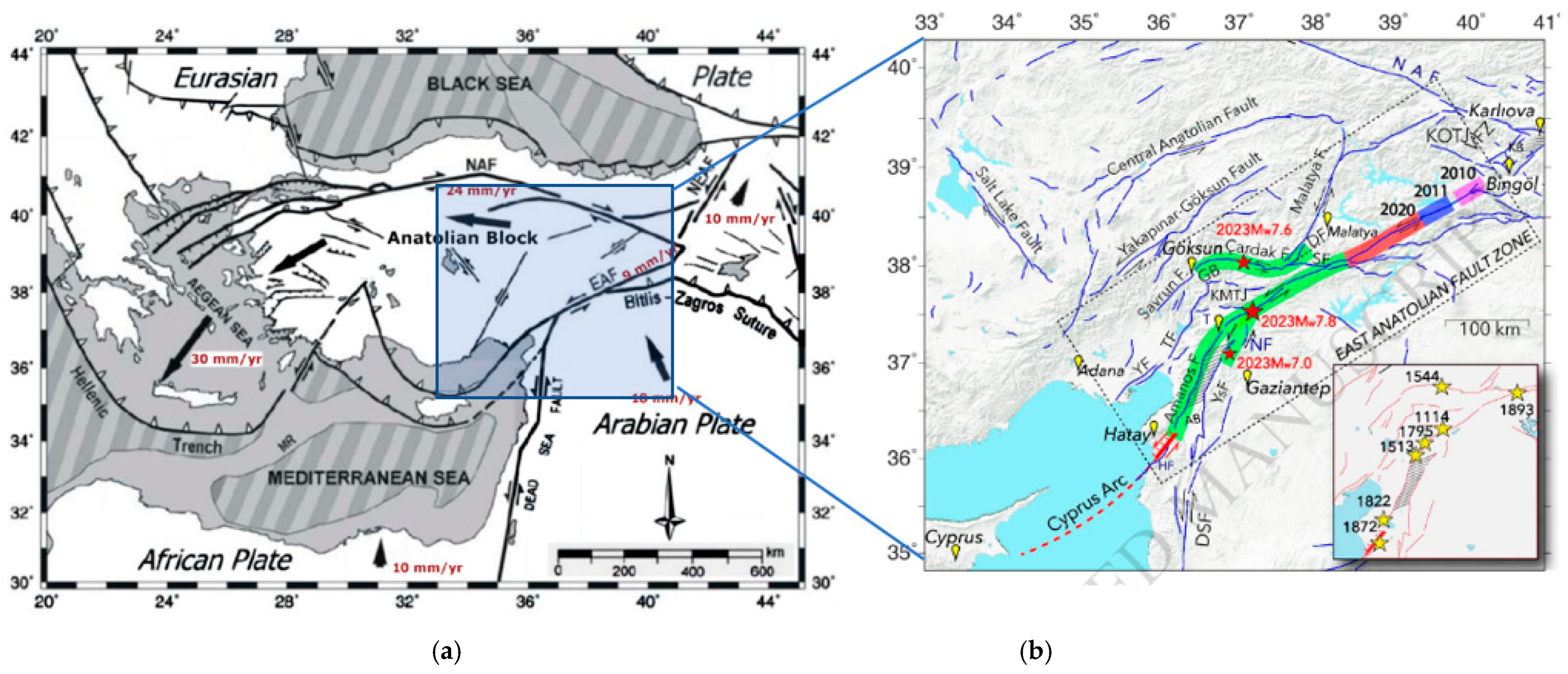
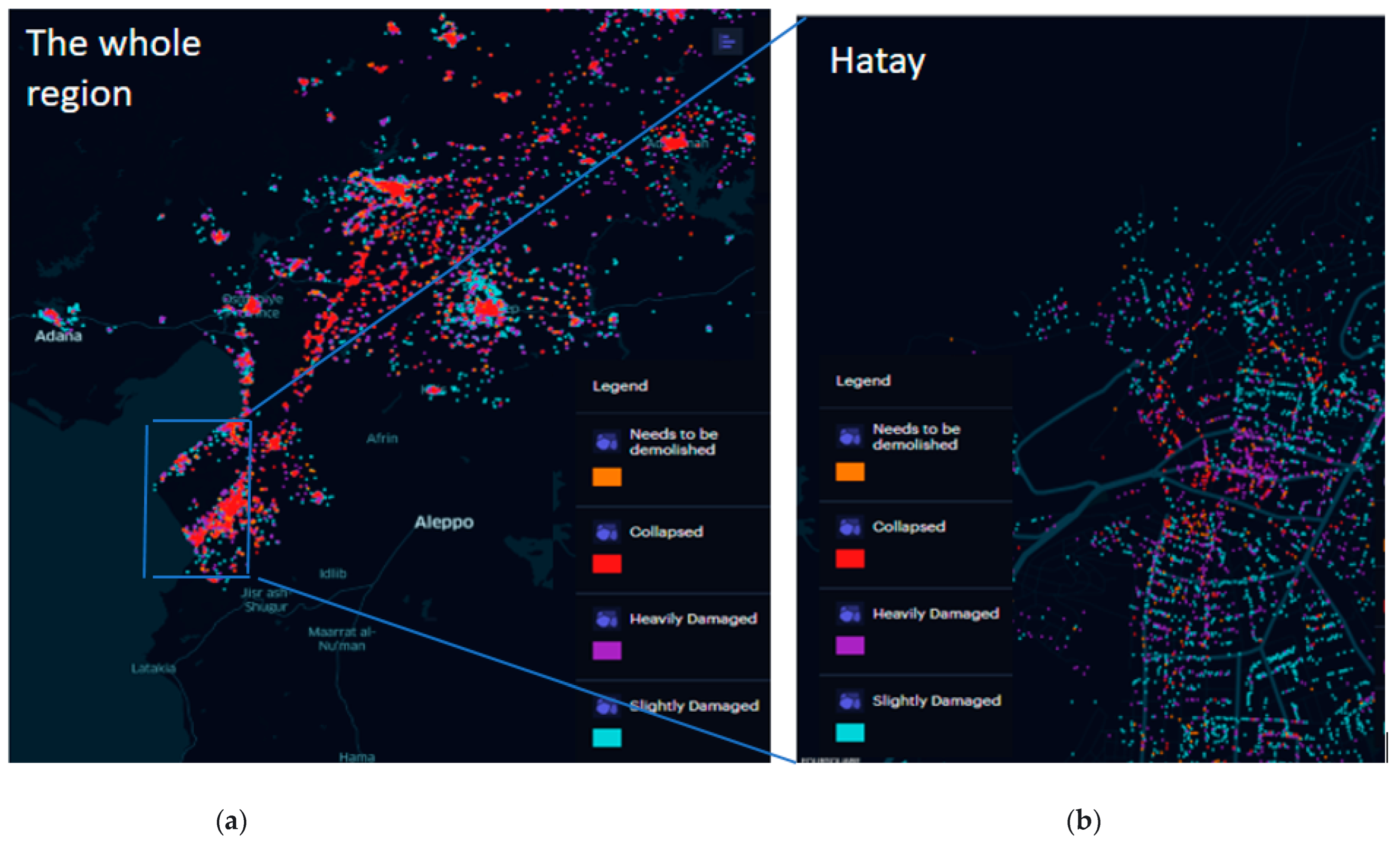
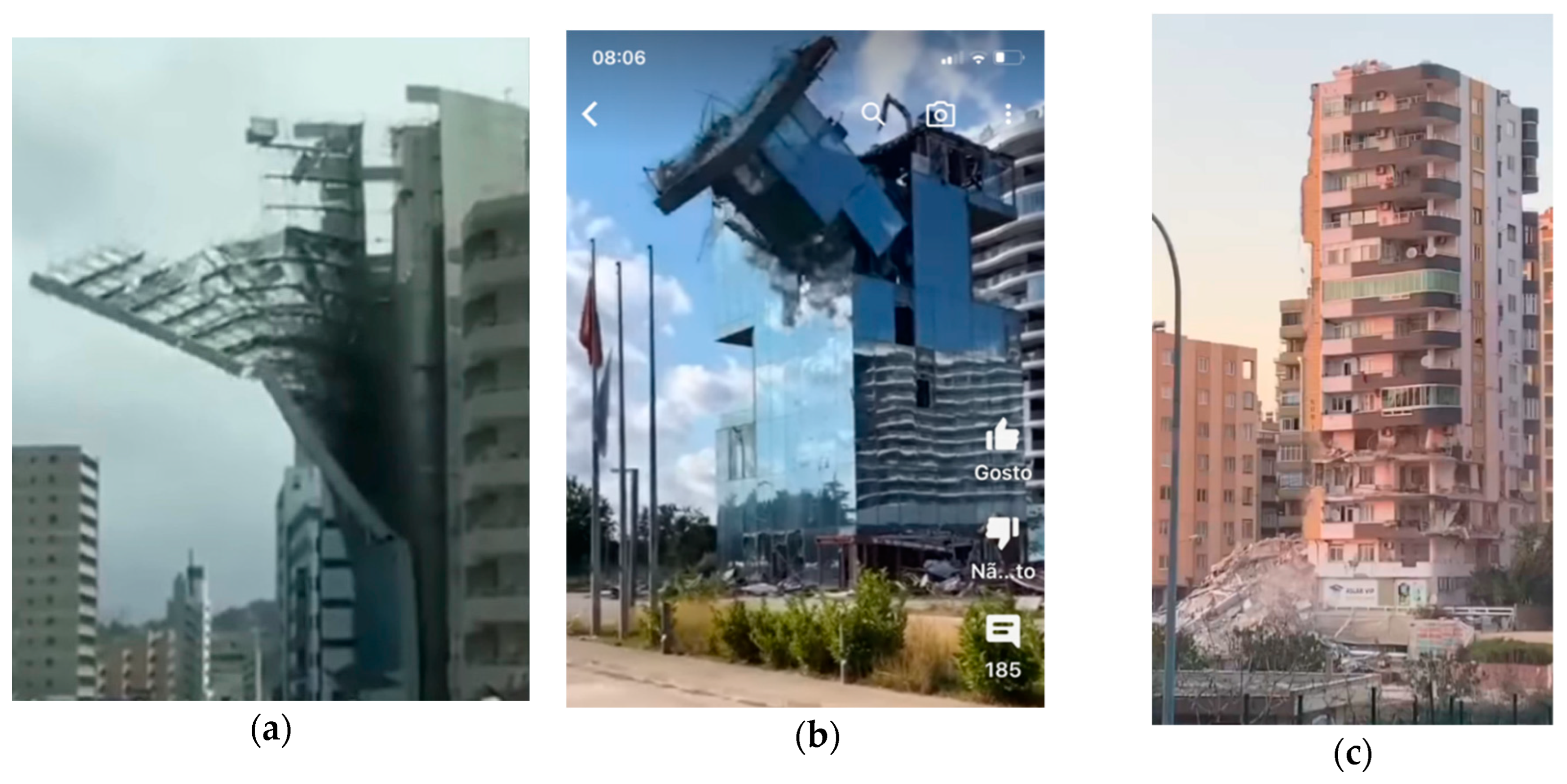
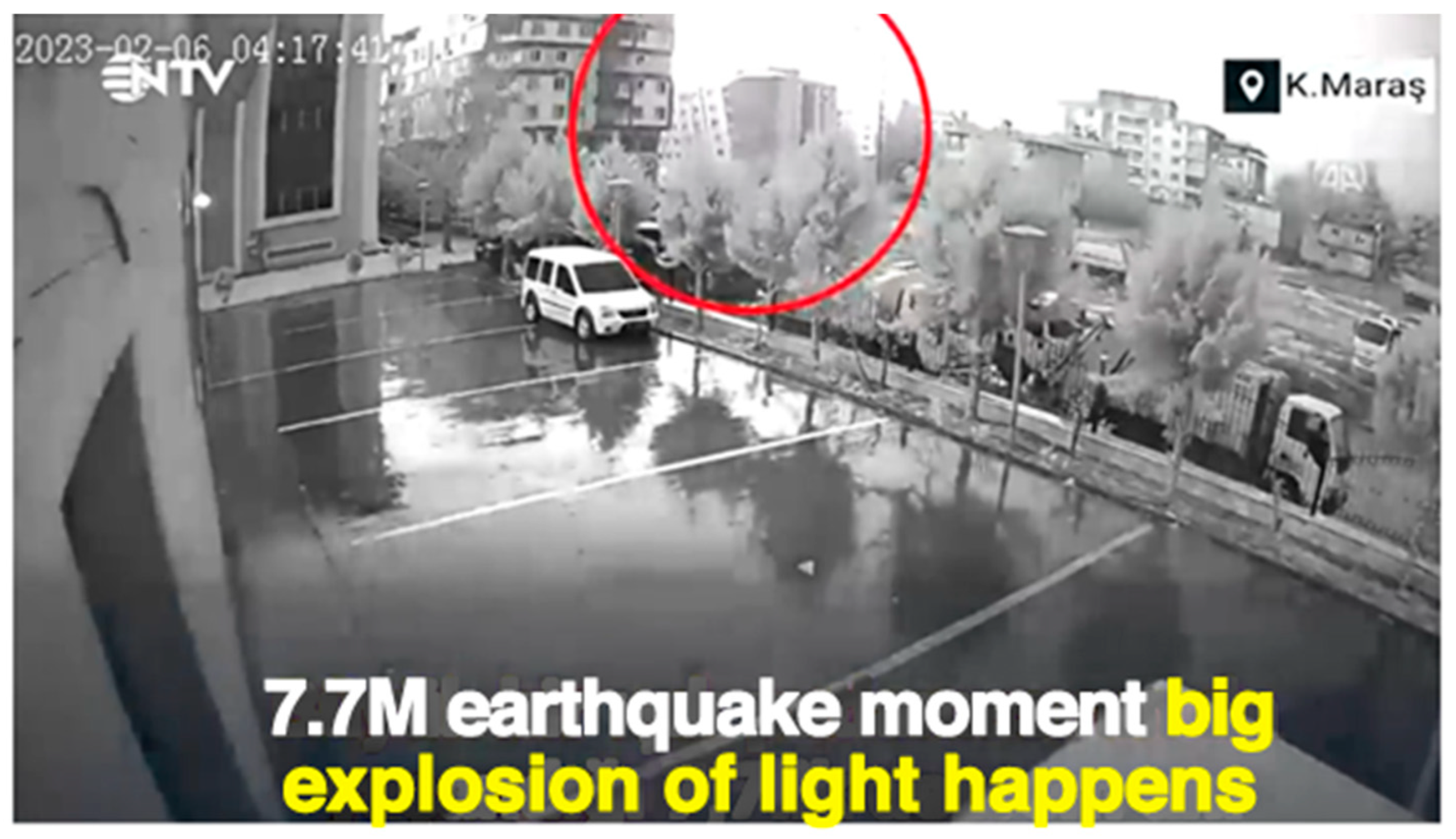

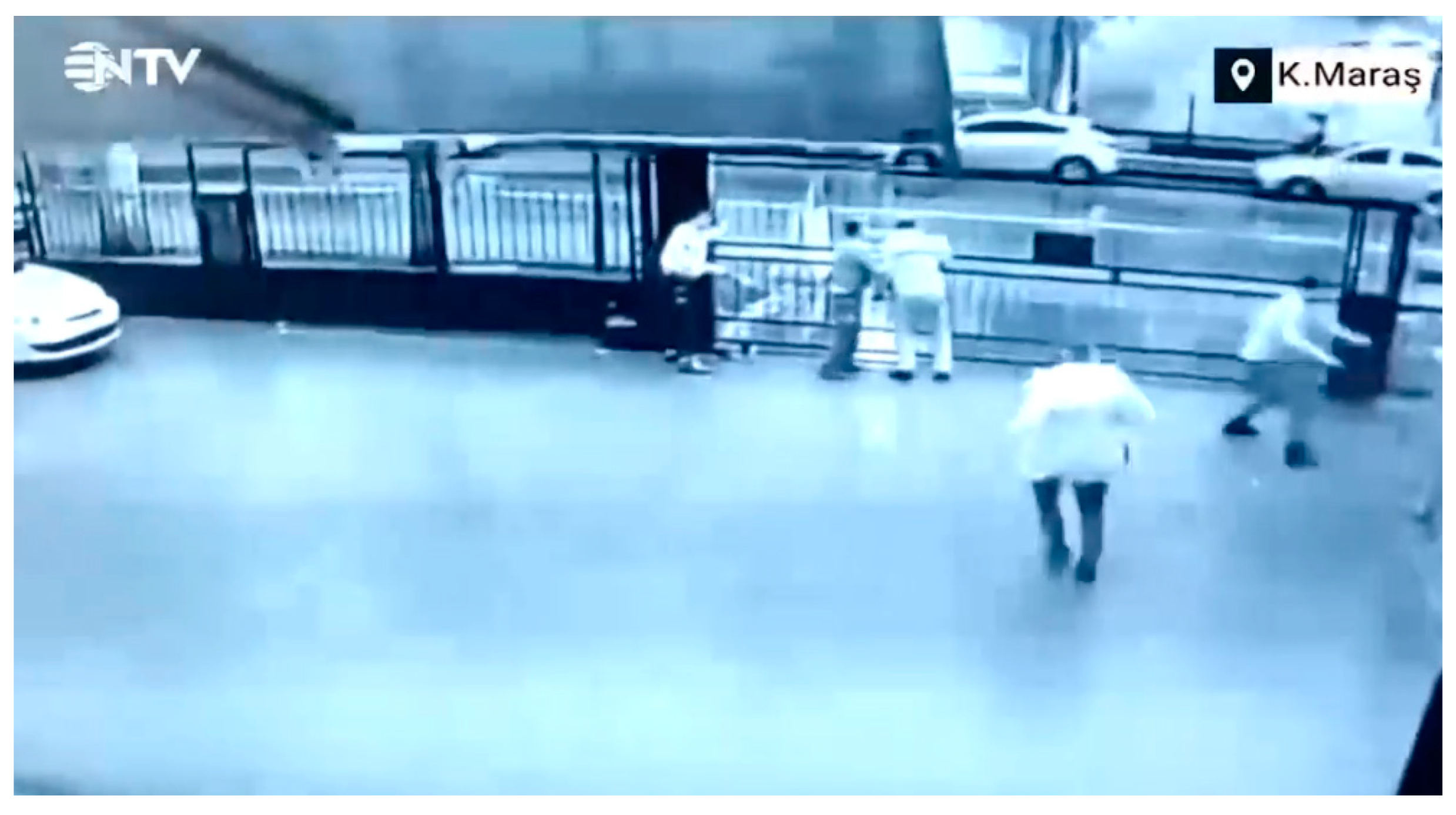
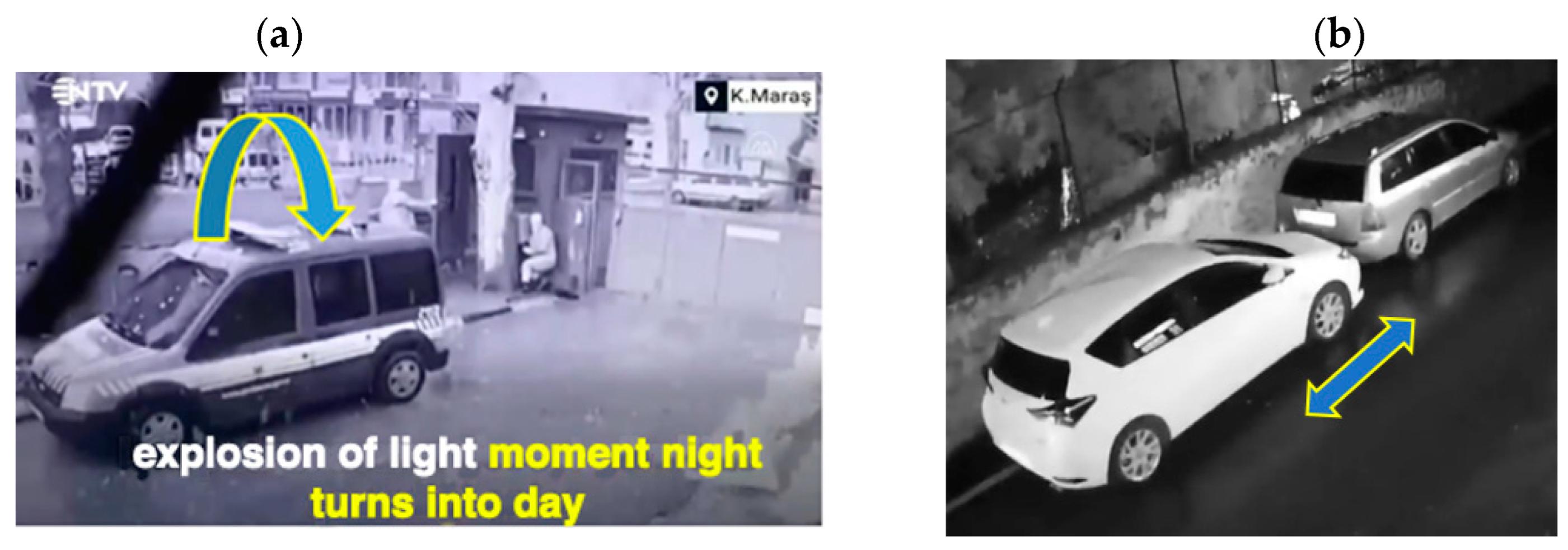




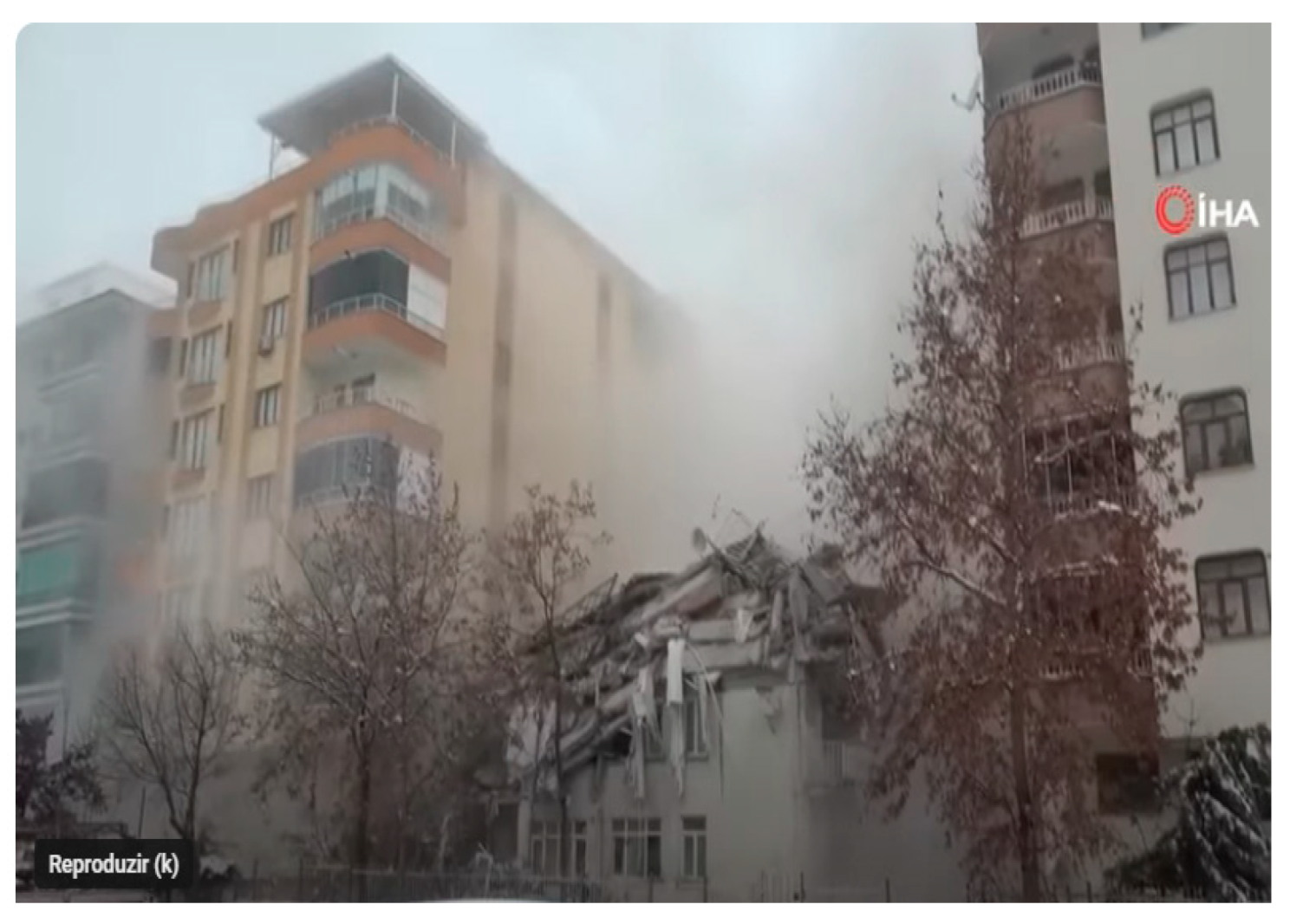


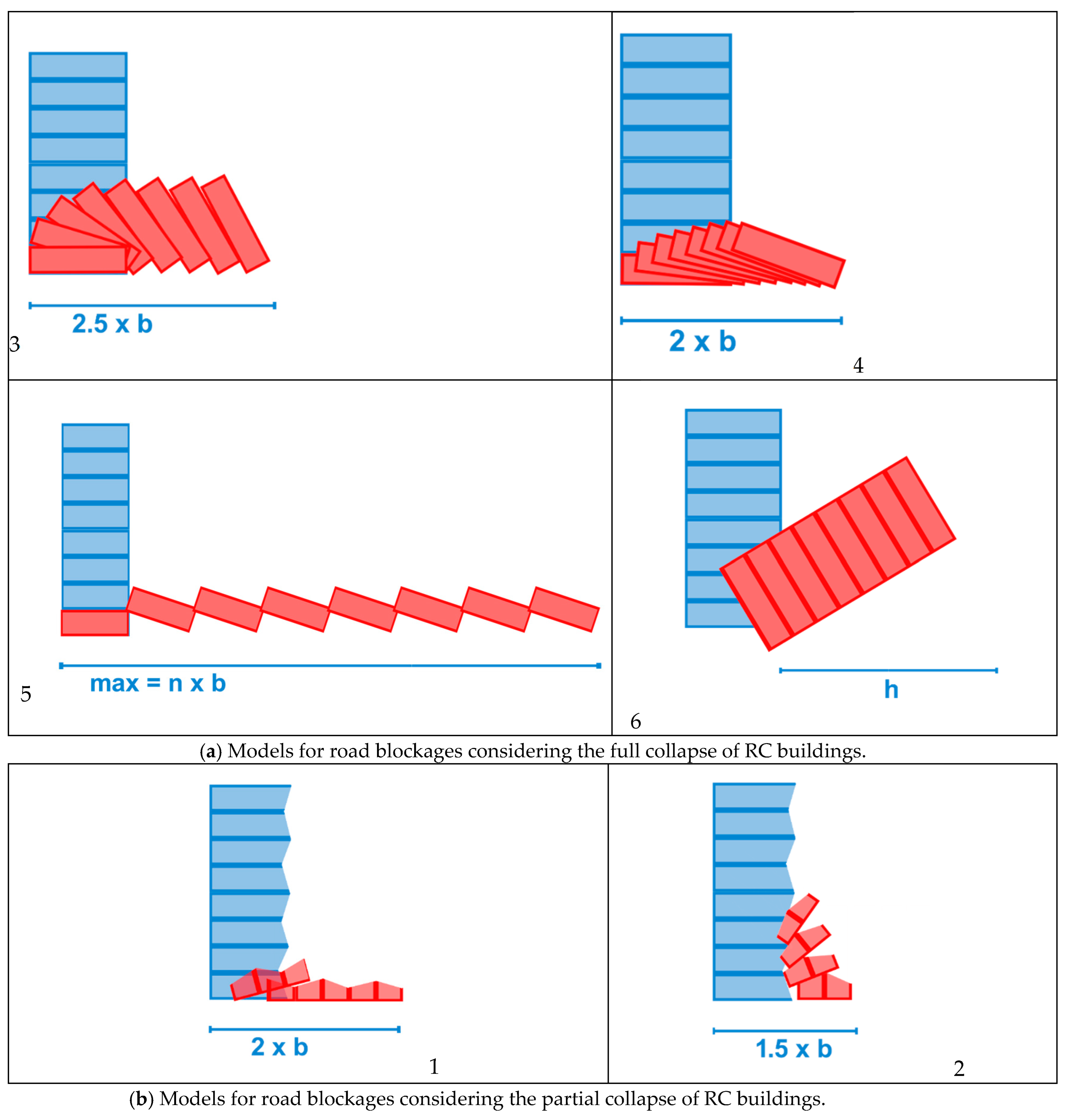
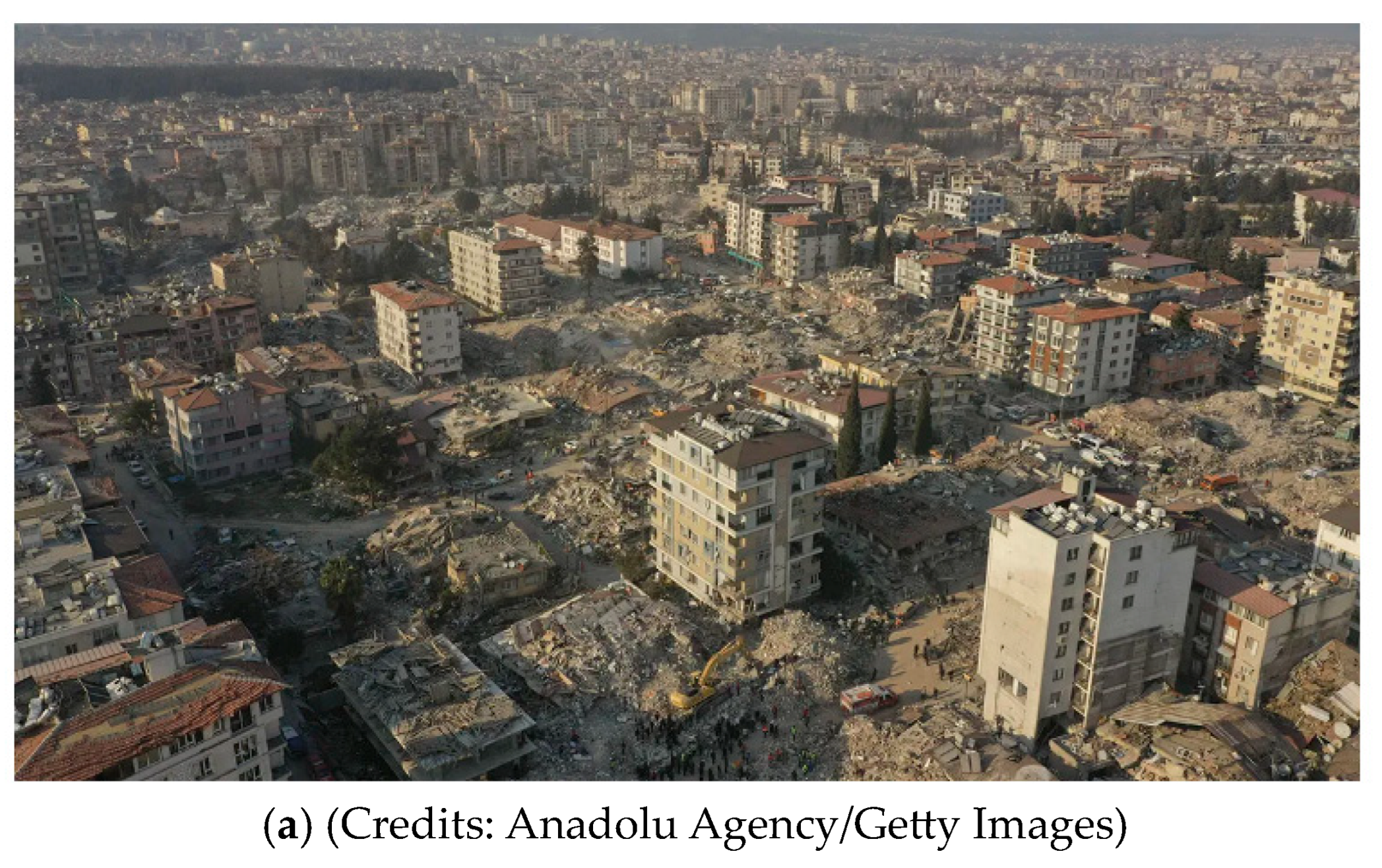
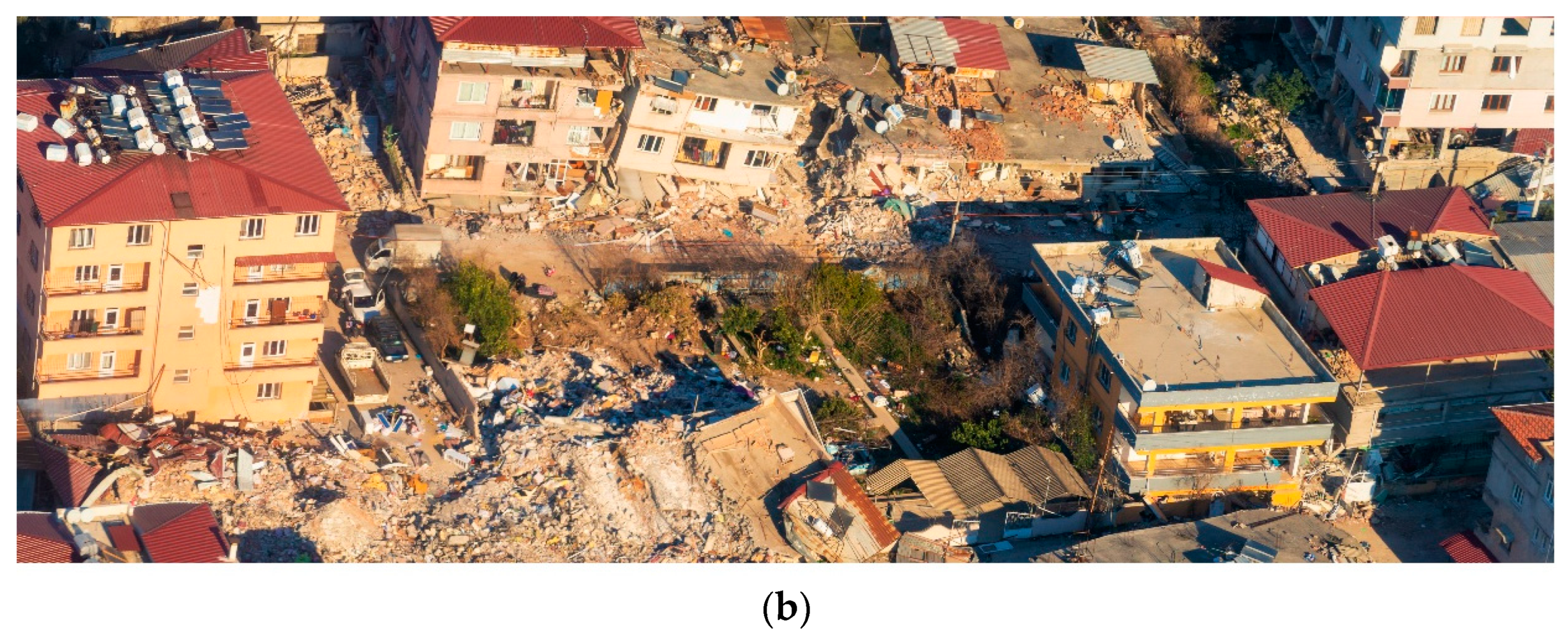
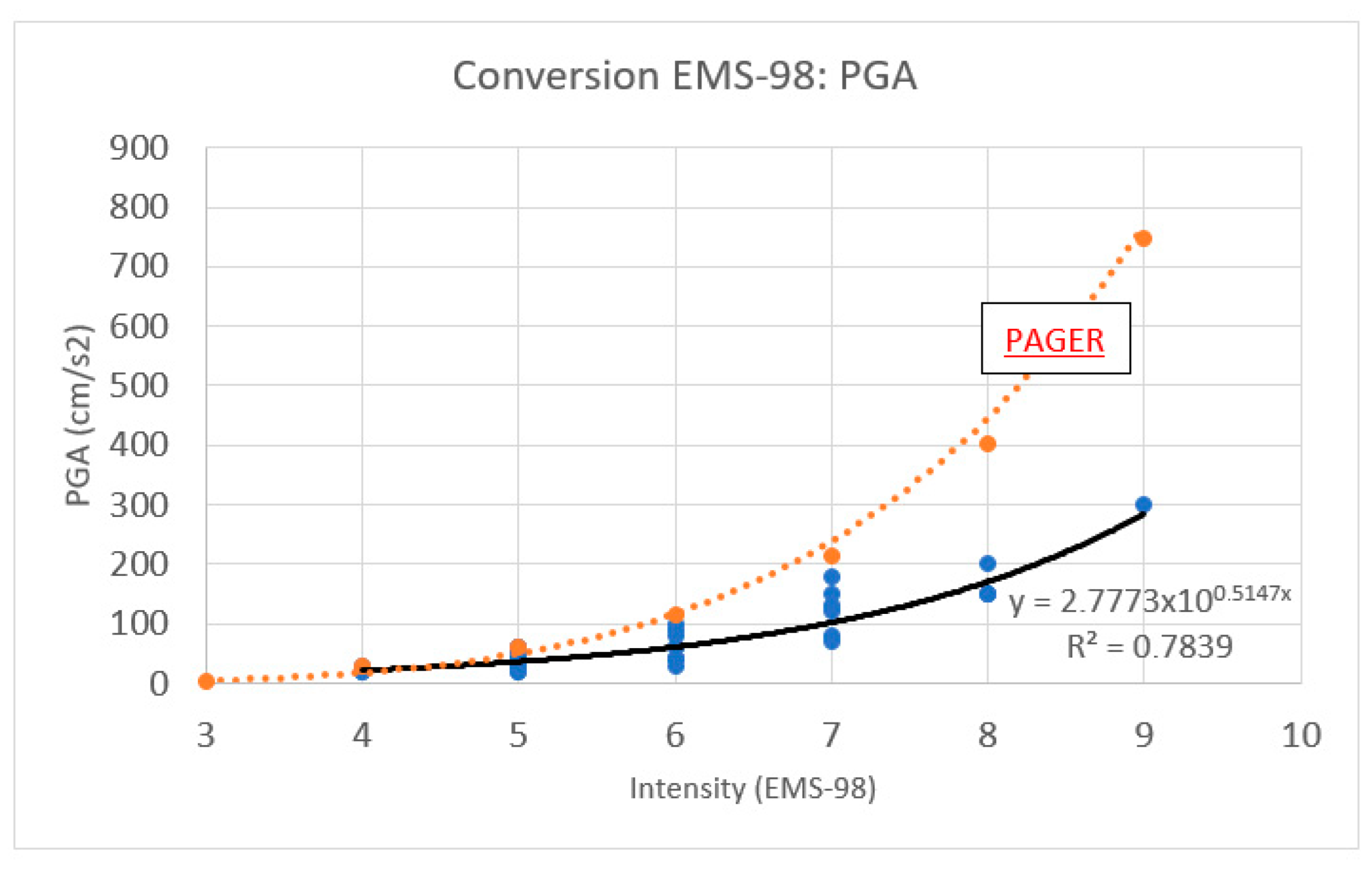
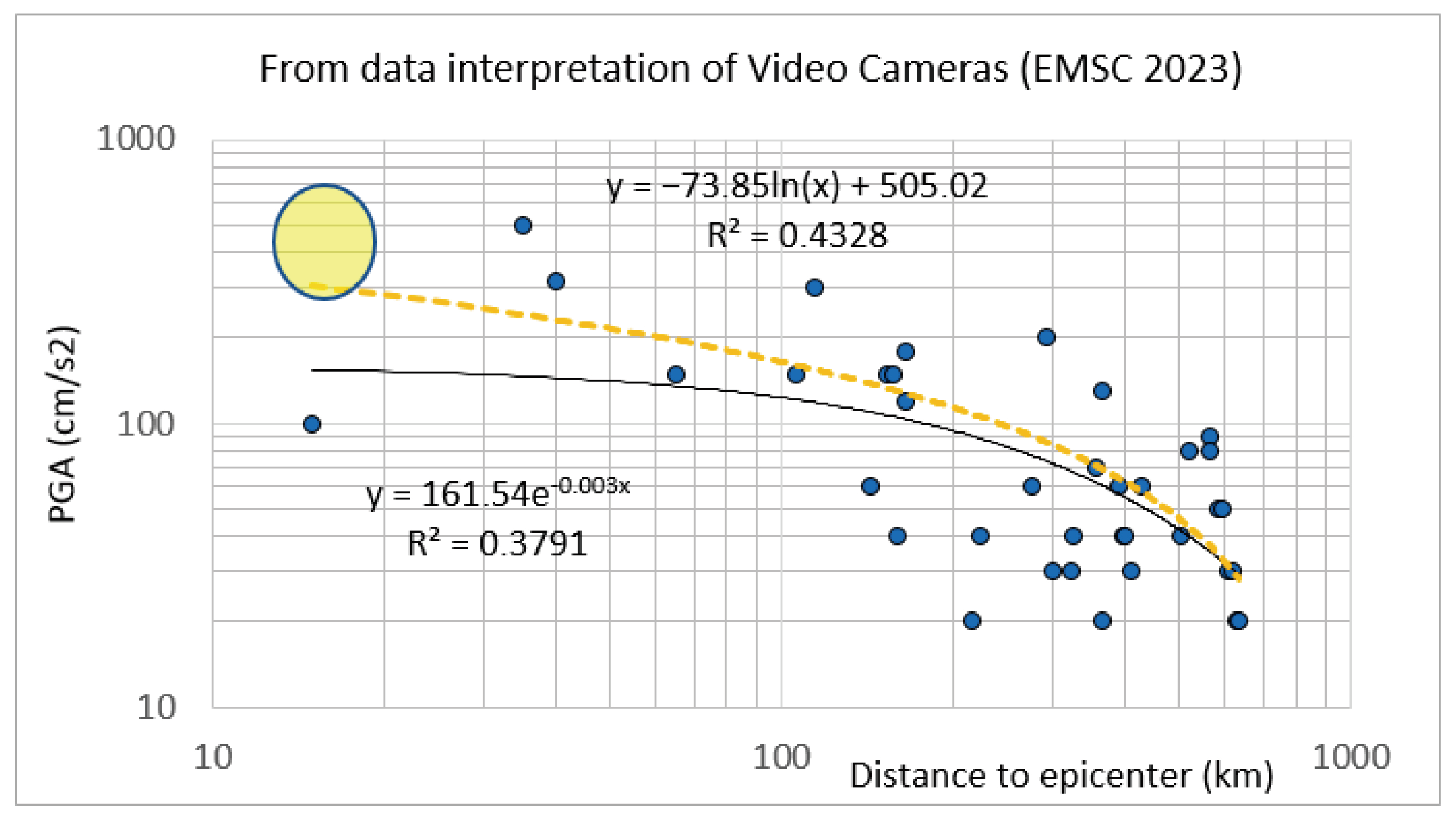
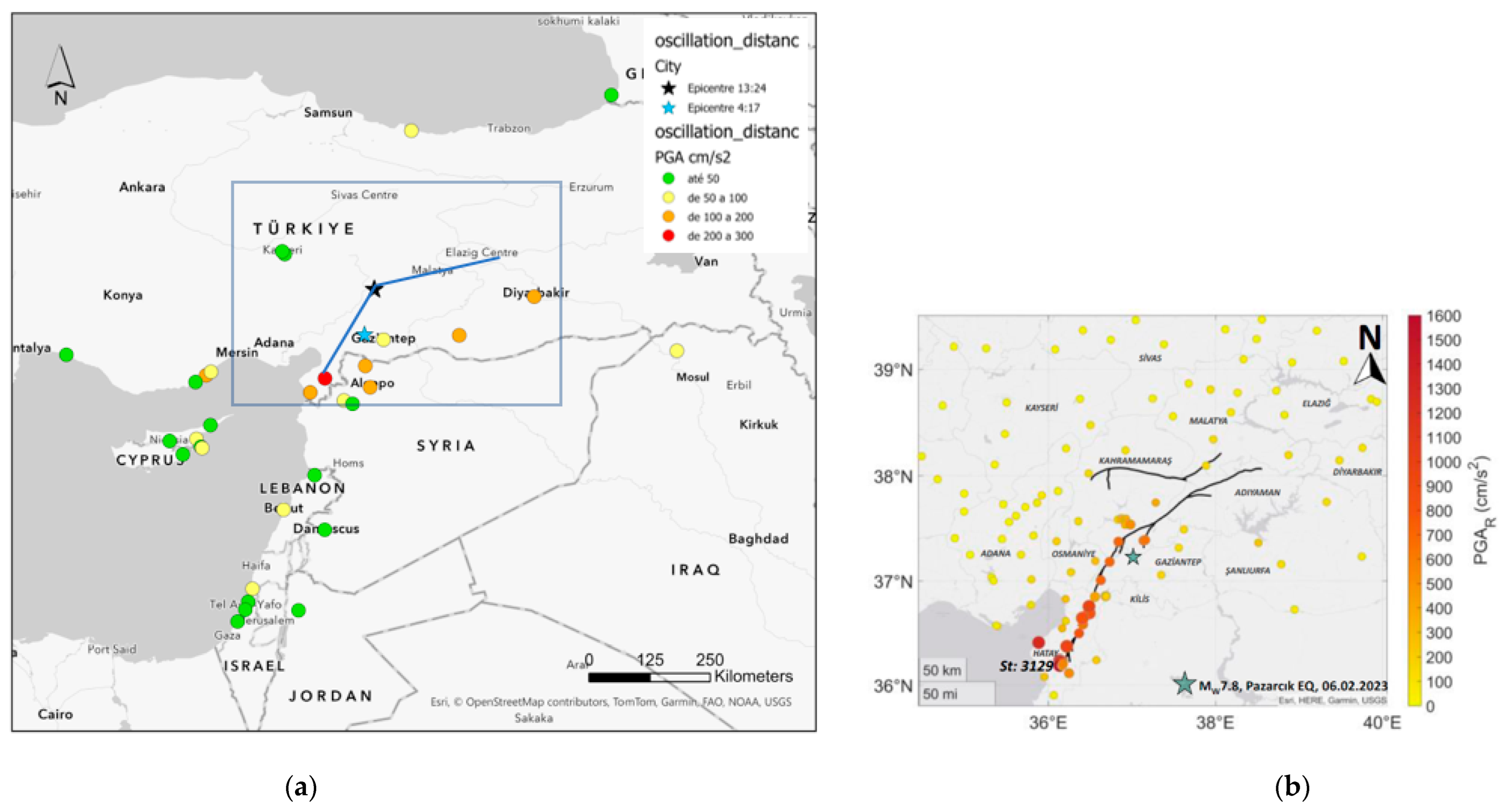
| Topic | Authors |
|---|---|
| Earthquake source | [15,16,17,18,19,20,21,22,23] |
| Surface deformation in the vicinity of fault ruptures | [24,25,26,27,28] |
| Ground motion | [29,30] |
| Geo-hazards | [31,32] |
| Building performance | [33,34,35,36] |
| Mosque and minaret performance | [37,38] |
| Codes | [39,40,41,42] |
| Post-earthquake clean-up and debris removal | [43] |
Disclaimer/Publisher’s Note: The statements, opinions and data contained in all publications are solely those of the individual author(s) and contributor(s) and not of MDPI and/or the editor(s). MDPI and/or the editor(s) disclaim responsibility for any injury to people or property resulting from any ideas, methods, instructions or products referred to in the content. |
© 2024 by the authors. Licensee MDPI, Basel, Switzerland. This article is an open access article distributed under the terms and conditions of the Creative Commons Attribution (CC BY) license (https://creativecommons.org/licenses/by/4.0/).
Share and Cite
Oliveira, C.S.; Ferreira, M.A.; O’Neill, H. The Role of Video Cameras and Emerging Technologies in Disaster Response to Increase Sustainability of Societies: Insights on the 2023 Türkiye–Syria Earthquake. Sustainability 2024, 16, 7618. https://doi.org/10.3390/su16177618
Oliveira CS, Ferreira MA, O’Neill H. The Role of Video Cameras and Emerging Technologies in Disaster Response to Increase Sustainability of Societies: Insights on the 2023 Türkiye–Syria Earthquake. Sustainability. 2024; 16(17):7618. https://doi.org/10.3390/su16177618
Chicago/Turabian StyleOliveira, Carlos Sousa, Mónica Amaral Ferreira, and Hugo O’Neill. 2024. "The Role of Video Cameras and Emerging Technologies in Disaster Response to Increase Sustainability of Societies: Insights on the 2023 Türkiye–Syria Earthquake" Sustainability 16, no. 17: 7618. https://doi.org/10.3390/su16177618
APA StyleOliveira, C. S., Ferreira, M. A., & O’Neill, H. (2024). The Role of Video Cameras and Emerging Technologies in Disaster Response to Increase Sustainability of Societies: Insights on the 2023 Türkiye–Syria Earthquake. Sustainability, 16(17), 7618. https://doi.org/10.3390/su16177618







